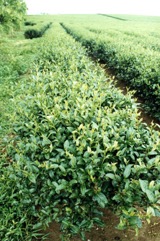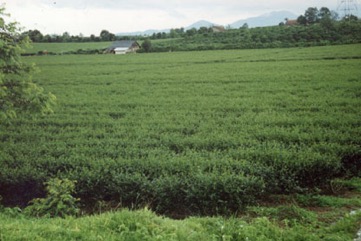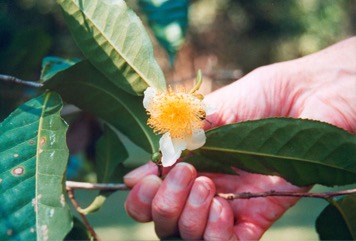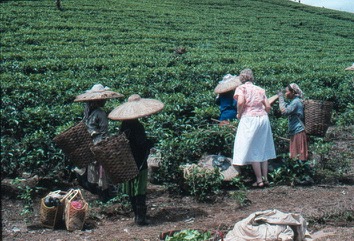Tea

A tropical and subtropical plant. It suits warm temperate climates. It needs light, humus rich soils. Soils should be well drained. A pH less than 6 is best. It requires an open sunny position. It is damaged by drought and by frost. It is common in the wet highlands of many tropical countries. A rainfall over 1,500 mm is suitable. Temperatures in the range 13°-30°C are suitable. In Nepal it grows between 450-1200 m altitude. It suits hardiness zones 10-12. Hobart Botanical Gardens. In Sichuan and Yunnan.
Also known as:
Cha, Chai, Chiya, Chashu, Chau-kung, Ditevazaha, Laphet, Perdu teh, Pokok cha, Pokok teh, Saa schein, Thayili, Theyaku, Tra
Synonyms
- Thea sinensis L.
- Thea bohea L.
- Thea viridis L.
- Camellia thea Link.
- Camellia theifera Griff.
- and others
Edible Portion
- Leaves - tea, Flowers, Seeds - oil
Where does Tea grow?
Found in: Africa, Asia, Australia, Bangladesh, Brazil, Burundi, Cambodia, Caucasus, China, East Africa, East Timor, Ethiopia, Europe, Fiji, Georgia, Hawaii, Himalayas, India, Indochina, Indonesia, Japan, Kenya, Korea, Laos, Madagascar, Malawi, Malaysia, Mauritius, Mozambique, Myanmar, Nepal, Northeastern India, Pacific, Papua New Guinea, PNG, Russia, Sao Tome and Principe, SE Asia, Sikkim, Sri Lanka, Taiwan, Tasmania, Thailand, Timor-Leste, Turkey, Uganda, United States, Vietnam, Zimbabwe
Notes: Green tea is made from freshly cut leaves and black tea is made from leaves which have been fermented. There are about 250-300 Camellia species. Tea contains about 50 mg of caffeine per cup. It has anticancer properties. Green tea probably helps against Cardiovascular Disease. Black tea has 21.1 mg per 100 g dry weight and 18.3 mg fresh weight of alpha-tocopherol (Vitamin E).
Growing Tea
Cultivation: Plants are normally grown by cuttings or layering. They can be grown from seed. Because the seed out breed, this produces a mixture of plants. For seed production special trees are kept and not pruned. The capsule matures after 9-12 months. Seed need to be sown fresh. Seeds can be sown in a nursery and transplanted, or sown and staked in the field. When seedlings are about 3-4 years old they are pruned back to about 10 cm from the ground then transplanted. From cuttings short stem cuttings with a single leaf and its bud in the leaf axil are used. These are grown in moist, shaded propagating nurseries. The cuttings are transplanted after about 1 year. Tea is commercially planted at 5,000-7,000 plants per hectare. That is a spacing of 1.2 m by 1.5 m. Trees are pruned to encourage side branches. The bush height is normally pruned to about 60 cm. The leaves grow in flushes at 70-90 day cycles. Two to four leaves are plucked each 7-14 days from the tree but only every 70-90 days from any one branch shoot. Plants are pruned back each 2-5 years.
Edible Uses: The leaves are used for tea. The leaves are fermented and eaten in Burma. They are prepared as a vegetable by mixing with garlic, salt, oil and other ingredients. The oil from the seeds is used as a sweetish seasoning and cooking oil.
Production: Young tips are plucked, then wilted on trays for 18-24 hours, then crushed between rollers and fermented for 18-24 hours before drying at 100°C for half an hour. A shrub can live for 100 years.
Nutrition Info
per 100g edible portion| Edible Part | Energy (kcal) | Protein (g) | Iron (mg) | Vitamin A (ug) | Vitamin c (mg) | Zinc (mg) | % Water |
|---|---|---|---|---|---|---|---|
| Leaves - tea | - | - | - | - | - | - |
Tea Photos




References
Ambasta S.P. (Ed.), 2000, The Useful Plants of India. CSIR India. p 99
Arora, R. K., 2014, Diversity in Underutilized Plant Species - An Asia-Pacific Perspective. Bioversity International. p 112
Barwick, M., 2004, Tropical and Subtropical Trees. A Worldwide Encyclopedic Guide. Thames and Hudson p 86
Bianchini, F., Corbetta, F., and Pistoia, M., 1975, Fruits of the Earth. Cassell. p 214
Bircher, A. G. & Bircher, W. H., 2000, Encyclopedia of Fruit Trees and Edible Flowering Plants in Egypt and the Subtropics. AUC Press. p 76
Bodkin, F., 1991, Encyclopedia Botanica. Cornstalk publishing, p 207 Bremness, L., 1994, Herbs. Collins Eyewitness Handbooks. Harper Collins. p 96
Brouk, B., 1975, Plants Consumed by Man. Academic Press, London. p 354
Burkill, I.H., 1966, A Dictionary of the Economic Products of the Malay Peninsula. Ministry of Agriculture and Cooperatives, Kuala Lumpur, Malaysia. Vol 1 (A-H) p 421
Bussman, R. W., et al, 2016, A comparative ethnobotany of Khevsureti, Samtskhe-Javakheti, Tusheti, Svaneti, and Racha-Lechkhumi, Republic of Georgia (Sakartvelo), Caucasus. Journal of Ethnobiology and Ethnomedicine.
Bussman, R. W. et al, 2017, Ethnobotany of Samtskhe-Javakheti, Sakartvelo (Republic of Georgia), Caucasus. Indian Journal of Traditional Knowledge Vol. 16(1) pp 7-24
Chen, B. & Qiu, Z., Consumer's Attitudes towards Edible Wild Plants, Ishikawa Prefecture, Japan. p 22 www.hindawi.com/journals/ijfr/aip/872413.pdf
Ching, L. S. & Mohamed, S., 2001, Alpha-Tocopherol Content in 62 Edible Tropical Plants. J. Agric. Food Chem. 2001, 49, 3101−3105
Cobley, L.S. (rev. Steele, W.M.) 2nd Ed., 1976, An Introduction to the Botany of Tropical Crops. Longmans. p 196
Cundall, P., (ed.), 2004, Gardening Australia: flora: the gardener's bible. ABC Books. p 310
Dharani, N., 2002, Field Guide to common Trees & Shrubs of East Africa. Struik. p 208
Engel, D.H., & Phummai, S., 2000, A Field Guide to Tropical Plants of Asia. Timber Press. p 144
Etherington, K., & Imwold, D., (Eds), 2001, Botanica's Trees & Shrubs. The illustrated A-Z of over 8500 trees and shrubs. Random House, Australia. p 175
Facciola, S., 1998, Cornucopia 2: a Source Book of Edible Plants. Kampong Publications, p 69
Gardner, S., et al, 2000, A Field Guide to Forest Trees of Northern Thailand, Kobfai Publishing Project. p 56
Hedrick, U.P., 1919, (Ed.), Sturtevant's edible plants of the world. p 146 (As Camellia thea)
Hu, Shiu-ying, 2005, Food Plants of China. The Chinese University Press. p 555
Katende, A.B., Birnie, A & Tengnas B., 1995, Useful Trees and Shrubs for Uganda. Identification, Propagation and Management for Agricultural and Pastoral Communities. Technical handbook No 10. Regional Soil Conservation Unit, Nairobi, Kenya. p 152
Kintzios, S. E., 2006, Terrestrial Plant-Derived Anticancer Agents and Plant Species Used in Anticancer research. Critical Reviews in Plant Sciences. 25: pp 79-113
Kiple, K.F. & Ornelas, K.C., (eds), 2000, The Cambridge World History of Food. CUP p 1866
Lazarides, M. & Hince, B., 1993, Handbook of Economic Plants of Australia, CSIRO. p 45
Liu, Yi-tao, & Long, Chun-Lin, 2002, Studies on Edible Flowers Consumed by Ethnic Groups in Yunnan. Acta Botanica Yunnanica. 24(1):41-56
Lord, E.E., & Willis, J.H., 1999, Shrubs and Trees for Australian gardens. Lothian. p 210
Lyle, S., 2006, Discovering fruit and nuts. Land Links. p 95
Manandhar, N.P., 2002, Plants and People of Nepal. Timber Press. Portland, Oregon. p 130
Marinelli, J. (Ed), 2004, Plant. DK. p 94
Martin, F.W. & Ruberte, R.M., 1979, Edible Leaves of the Tropics. Antillian College Press, Mayaguez, Puerto Rico. p 106, 221
Molla, A., Ethiopian Plant Names. http://www.ethiopic.com/aplants.htm
Murtem, G. & Chaudhrey, P., 2016, An ethnobotanical note on wild edible plants of Upper Eastern Himalaya, India. Brazilian Journal of Biological Sciences, 2016, v. 3, no. 5, p. 63-81.
Pham-Hoang Ho, 1999, An Illustrated Flora of Vietnam. Nha Xuat Ban Tre. p 430
Phon, P., 2000, Plants used in Cambodia. © Pauline Dy Phon, Phnom Penh, Cambodia. p 126
Plants for a Future database, The Field, Penpol, Lostwithiel, Cornwall, PL22 0NG, UK. http://www.scs.leeds.ac.uk/pfaf/
Polunin, O., & Stainton, A., 2006, Flowers of the Himalaya, Oxford India Paperbacks. p 58
Purseglove, J.W., 1968, Tropical Crops Dicotyledons, Longmans. p 599
Rashid, H. E., 1977, Geography of Bangladesh. Westview. p 303 (As Thea camellia)
Recher, P, 2001, Fruit Spirit Botanical Gardens Plant Index. www.nrg.com.au/~recher/ seedlist.html p 3 (As Thea sinensis)
Reis, S. V. and Lipp, F. L., 1982, New Plant Sources for Drugs and Foods from the New York Botanical Garden herbarium. Harvard. p 185 (As Thea oleosa)
Savita, et al, 2006, Studies on wild edible plants of ethnic people in east Sikkim. Asian J. of Bio Sci. (2006) Vol. 1 No. 2 : 117-125
Smith, A.C., 1981, Flora Vitiensis Nova, Lawaii, Kuai, Hawaii, Volume 2 p 322
Smith, N., Mori, S.A., et al, 2004, Flowering Plants of the Neotropics. Princeton. p 370
Solomon, C., 2001, Encyclopedia of Asian Food. New Holland. p 376
Staples, G.W. and Herbst, D.R., 2005, A tropical Garden Flora. Bishop Museum Press, Honolulu, Hawaii. p 546
Sukarya, D. G., (Ed.) 2013, 3,500 Plant Species of the Botanic Gardens of Indonesia. LIPI p 603
Sukenti, K., et al, 2016, Ethnobotanical study on local cuisine of the Sasak tribe in Lombok Island, Indonesia. Journal of Ethnic Foods. 3 (2016) 189-200 p 198
Syarfina, F., et al, 2017, The relation between green tea consumption and CVD (cardiovascular disease) development as action plan for the prevention and control: A systematic review. China Botanical Congress.
Trudy Imp. S.-Peterburgsk. Bot. Sada 10:195. 1887*
Valder, P., 1999, The Garden Plants of China. Florilegium. p 148
van Wyk, B., 2005, Food Plants of the World. An illustrated guide. Timber press. p 112
Vickery, M.L. and Vickery, B., 1979, Plant Products of Tropical Africa, Macmillan. p 59
Visser, T., 1979, Tea, in Simmonds N.W.,(ed), Crop Plant Evolution. Longmans. London. p 18
Williams, C.N., Chew, W.Y., and Rajartnam, J.A., 1989, Tree and Field Crops of the Wetter Regions of the Tropics. Longman, p 68
Williamson, J., 2005, Useful Plants of Malawi. 3rd. Edition. Mdadzi Book Trust. p 50
Woo, Y., et al, 2017, Antioxidant Potential of Selected Korean Edible Plant Extracts. Hindawi BioMed Research International Volume 2017, Article ID 7695606
www.wildediblefood.com
Yasukawa, K., Medicinal and Edible Plants as Cancer Preventive Agents. Drug Discovery Research in Pharmacognosy. p185 www.intechopen.com
Young, J., (Ed.), 2001, Botanica's Pocket Trees and Shrubs. Random House. p 188